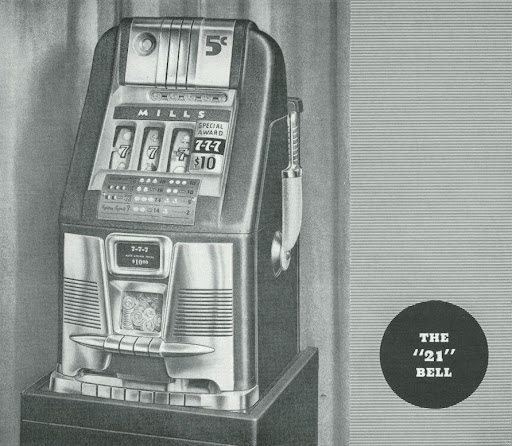Now that I’ve spent some time tinkering with the machine, I’m really anxious to get started on the tear-down. The machine has some potential, and should be a fun machine to play once the restoration is complete.
Let me talk for a minute, however, about the Mills High Top in general. A lot of collectors turn their noses up at the venerable High Top and treat it like a second-class citizen. Their reasoning is that the machine is so plentiful that it isn’t worth collecting. Also, the High Top had so many variations and after-market modifications that it’s difficult to determine exactly what would be considered original.
While all of these points are accurate, I’m a fan of the High Top line of slots. Don’t get me wrong, there are many other machines that I’d like to see drop into my lap, but I think the High Top gets a bad rap. Here are its strong points, particularly from the perspective of a beginning collector:
- The High Top is plentiful, and examples can often be acquired for a reasonably inexpensive price if you are willing to put in some “sweat equity” on a restoration.
- High Top parts are relatively easy to come by.
- The High Top mechanism is very solid.
In addition, since the High Top had so many variations, you don’t have to worry so much about destroying value if you decide to paint the machine in a non-standard color or take some liberties in the restoration.
I consider the Mills High Top to be the “last hurrah” of the purely mechanical slot machines. The Jennings machines started featuring electric lights, and then the electromechanical Bally machines of the 1960s changed the game forever. The High Top belongs to an earlier, simpler age, and that appeals to me.
Anyway, once I acquired the machine featured in this series of articles I started looking for information that would help me nail down as many specifics as possible about the machine. I checked all of the standard reference books, including the following:
Lemons, Cherries and Bell-Fruit-Gum by Richard M. Bueschel
Slot Machine Buyer’s Handbook by David L. Saul and Daniel R. Mead
Collector’s Guide to Vintage Coin Machines by Richard M. Bueschel
Owners Pictorial Guide for the Care and Understanding of the Mills Bell Slot Machine by Robert N. Geddes
Slot Machines of Yesteryear: Operator’s Companion -Mills of the Forties by Dan R. Post
I looked at several other books as well, plus a good many websites, but I ended up finding a photo on page 61 of Collector’s Guide to Vintage Coin Machines that pretty much gave me what I was looking for. I’m not going to scan and post the photo out of respect for the memory of author Dick Bueschel who gave the coin-op collecting hobby so much through his meticulous research, but I’m happy to describe the photo to you. It shows a nickel machine labeled as a “21 Bell” that is pretty much identical to my machine. Bueschel dates the machine to 1949, during the Bell-o-Matic years at the Mills Novelty Company, which looks consistent with the workings of the machine.
Slot Machines of Yesteryear: Operator’s Companion – Mills of the Forties has a couple of ad reprints that show the machine clearly plus some reprints of parts manuals and such. This book and the Mills of the Thirties version are indispensable resources.
I also checked out some of the downloadable documents at Ray’s Antique Slot Machine website, and found some sales literature that shows a slightly different version of the machine.
Other than the small difference in the lower front casting, this machine is a spot-on match.
In their typical ultra-positive marketing language, Mills describes the machine as follows:
It has tremendous earning power, entirely new award principle, powerful play incentive. “21″ Bell is a completely new innovation of payout awards. It is our answer for the need of a new award principle. It’s a Bell with 10 mystery payouts, a double Jackpot possibility called 7-7-7 and three new ways of winning the Jackpot by the lineup of bars, melons, and a combination of bars and melons. It’s the players’ dream Bell because its idea was created by one of the outstanding Bell operators in the country. Glowing reports about the wonderful earnings of “21″ Bell are coming to us from all over the country. Mills “21″ Bell is now ready for operators and clubs.
5c, 10c, 25c and 50c Denomination
So, considering all of this information I think it’s fair to say that we’ve definitively identified our machine. Personally, I take almost as much pleasure from the hunt for information as I do from the mechanical aspects, and it’s an important step in any restoration. Don’t skip it!
